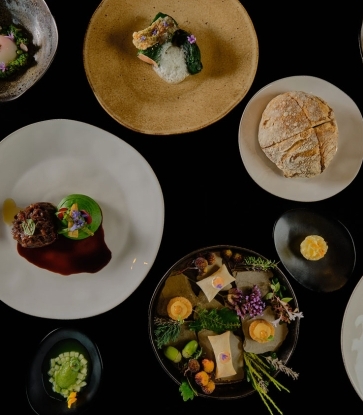Pomegranates are a superfood in a multitude of ways. Nutritionally dense, they contain more antioxidants than green tea or red wine. Their thick skin, once used by ancient cultures to dye leather, encapsulates hundreds of ruby red arils surrounding seeds that are used in cooking, juices and cocktails. Steeped in folklore as a symbol of both joy and fertility for newly-married couples, pomegranates are plucked from a shrub or tree known for its longevity. Pomegranate trees still standing in L’Orangerie, the grand garden at the Palace of Versailles, are believed to be more than 200 years old.
The first pomegranates are believed to have come from Iran, northern India and throughout the Mediterranean, where they are believed to be one of the first fruit trees cultivated for domestic use. Ancient explorers made the most of the fruit’s sturdy and long lasting nature by carrying them on desert explorations to quench their thirst. Pomegranates were first brought to the United States by Spanish colonizers in the late 1700s. Today, pomegranates are grown across the Middle East, Africa, Asia, the Mediterranean and in California and Arizona in the United States.
Pomegranates have played a distinct role in numerous cultures and religions. They are mentioned in many religious texts, including the Bible and the Quran. Iranian weddings often feature a basket of pomegranates as a foretelling of a joyous future for the couple, and some Turkish brides break a pomegranate on the ground with the number of arils emerging thought to predict the number of children the couple will have. Pomegranates, or items adorned with pomegranates, are a popular wedding gift in China, symbolizing a prosperous and fertile future.
When selecting the perfect pomegranate, look for a brilliant red skin with a smooth, dent- or scratch-free surface that is firm to the touch. Pomegranates are typically at their peak from September through February. Avoid pomegranates that give when squeezed gently or those that are pale or pink in color, as those fruit are likely underripe. The fruit should be the size of a large orange and should feel heavier than it looks. Inside that bright red shell, are hundreds of tiny, red jewel-like seeds and arils, which are the coverings of each seed, that are held in place by a white membrane. The arils, the edible portion of the pomegranate, should be plump, shiny and full of juice. It’s the juice-filled arils that give pomegranates their weight and firmness. As they grow and fill with juice, the arils press against the shell providing extra resistance when the fruit is gently squeezed.
Pomegranate arils and their juice are common ingredients in a variety of cuisines around the world. Iranian cooks use the juice to marinate meat, and syrups made from the juice were used as a sweetener. A sauce made with pomegranate juice is used as a salad dressing in Turkey and the arils are used by cooks around the world to add tartness, color and a mild crunch to everything from salads to soups. A reduction of the juice is how you get pomegranate molasses, a staple ingredient of traditional Middle Eastern recipes.
Pomegranates are classified as a superfood due to their numerous health benefits. They make an excellent low calorie snack and are high in Vitamin C, potassium and fiber. Pomegranate juice contains high levels of the most powerful antioxidants that are believed to help lower cholesterol, prevent heart disease and control diabetes. These same antioxidants help fight inflammation and prevent joint damage in people with osteoarthritis.
Fall and winter menus at MICHELIN-recommended restaurants often feature pomegranates, both the arils and juice, in everything from appetizers to cocktails. Sababa, a Mediterranean restaurant in Washington, D.C., highlights pomegranates on their small plates menu with pomegranate-glazed chicken liver with sumac onions and pomegranate seeds. Their cocktail menu includes a Zephyr Breeze, a mix of rum, pomegranate soda, rose hip and sumac. The Southern Soul menu at Los Angeles’s Preux & Proper lists chicken fried pork belly adorned with pickled radish, refried red beans, pineapple verde, blue corn crumble and a pomegranate-habanero glaze. At Bellota in San Francisco, pomegranate-loving diners will find calabaza squash roasted with apple, red onion, pomegranate and a sheep’s milk crema on the tapas menu.
Pomegranates add a healthy burst of flavor to most any dish and can elevate a simple salad or cocktail to new levels of taste.

Feld Earns One MICHELIN Star in Year Two
Chef Jake Potashnick serves 25 to 30 thoughtfully composed bites, delivering a truly memorable dining experience.

A Four-Day Culinary Journey Through Bordeaux, According to The MICHELIN Guide
The MICHELIN Guide visited Bordeaux on a four-day, autumnal journey through the famed wine region’s vineyards and restaurants.

What Is The MICHELIN Bib Gourmand Award?
Since 1997, The MICHELIN Guide’s Bib Gourmand has celebrated restaurants worldwide that serve exceptional food at great value— here’s what makes it special.

What is a MICHELIN Star?
The MICHELIN Guide explained — criteria for Stars; One Star versus Two Stars versus Three Stars; how service and decor factor in; and more. All your questions answered by our MICHELIN Guide Inspectors.
















